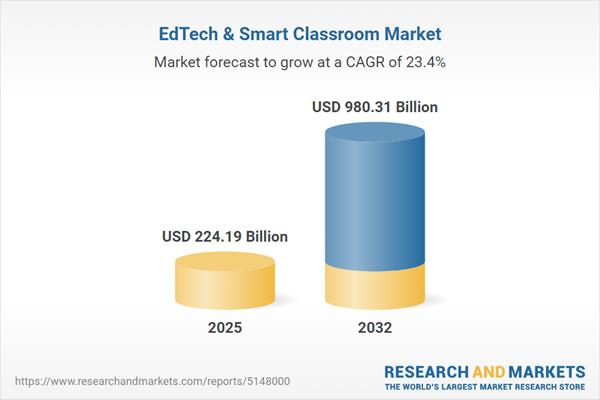Speak directly to the analyst to clarify any post sales queries you may have.
The EdTech & Smart Classroom Market represents a strategic pivot for organizations modernizing digital learning and workforce development. Senior decision-makers increasingly turn to technology-driven solutions to adapt to evolving operational demands, create resilient educational pathways, and support organizational innovation.
Market Snapshot: EdTech & Smart Classroom Market
In 2024, the global EdTech & Smart Classroom Market stands at USD 182.26 billion and is projected to achieve USD 224.19 billion by 2025, reflecting a CAGR of 23.40%. This notable growth underscores a fast-moving shift across private enterprises and educational institutions toward advanced digital learning platforms. Stakeholders are responding to increased learner expectations and operational complexity by accelerating investments in digital infrastructures. These investments target enhanced learner engagement, agile instructional delivery, and improved institutional competitiveness. Companies and educational providers are focusing on adaptive strategies that integrate digital platforms for a seamless learning experience, supporting a broad range of environments including K-12, higher education, and enterprise workforce upskilling.
Scope & Segmentation
- Deployment Modes: Cloud-based solutions offer organizations increased agility, collaborative reach, and reduced maintenance, while on-premise deployments remain essential for situations with strict data privacy or legacy infrastructure needs.
- Core Components: Integrated learning ecosystems use interactive displays and smart whiteboards, combining hardware with adaptive software to create personalized and engaging educational experiences. Professional services play a key role in effective rollout and ongoing support.
- End Users: Diverse user groups include enterprises focused on strategic workforce development, higher education aiming to enrich learning quality, and K-12 schools emphasizing digital assessments and student engagement.
- Key Applications: Solutions focus on centralized administrative control, real-time learner assessment, virtual collaboration, and comprehensive content management to streamline institutional operations and support effective teaching.
- Enabling Technologies: Artificial intelligence, machine learning, and natural language processing drive personalized instruction and analytics. Augmented and virtual reality deliver immersive learning, while blockchain and IoT technologies offer heightened data security and visibility.
- Regional Coverage: The market demonstrates robust adoption across the Americas, Europe, the Middle East and Africa, and Asia-Pacific. Regional dynamics vary: for example, China, India, Japan, Southeast Asia, Australia, and South Korea show unique patterns of adoption influenced by modernization efforts, education reform, and digital growth.
Key Takeaways for Senior Decision-Makers
- Organizations benefit from balancing cloud and on-premise platforms to navigate operational and compliance requirements effectively while remaining adaptable to regulatory variations.
- The application of artificial intelligence within educational solutions enables deeper customization and improved quality of learning aligned with institutional goals.
- Standardizing digital tools and processes improves accessibility across teams and geographies, supporting scalable implementation and consistent learner experiences.
- Collaborating with specialized implementation partners streamlines technology integration, simplifying complex deployments and supporting rapid adoption of advanced EdTech systems.
- Continuous investment in organizational training and robust change management supports ongoing workforce engagement and offers clearer visibility into educational performance analytics.
Tariff Impact: Navigating a Changing Trade Environment
Recent tariff adjustments targeting imported EdTech hardware such as interactive displays and sensors in the U.S. have prompted organizations to reassess both procurement and supply chain strategies. Market participants are minimizing operational risks by diversifying supplier relationships and shifting sourcing closer to key regions. This realignment, combined with more flexible financing options, enables ongoing investments in digital learning assets amidst uncertain trade and regulatory conditions. Companies remain focused on ensuring continuity of supply while optimizing cost structures in response to evolving tariff landscapes.
Methodology & Data Sources
This analysis builds on primary research through interviews with senior executives, subject matter experts, and operational leaders. The methodology integrates scenario-based planning and iterative validation to deliver strategic recommendations tailored for the dynamic EdTech & Smart Classroom Market.
Why This Report Matters
- Empowers senior executives to shape robust digital learning strategies that align with workforce objectives and technology shifts.
- Clarifies varying regional regulations and technology standards, supporting informed operations and investment planning.
- Promotes sustainable technology adoption by emphasizing strategic partnerships and adaptability across educational and enterprise environments.
Conclusion
This report equips organizational leaders with actionable insights to align technology investments with broader learning strategies and support ongoing digital transformation initiatives.
Additional Product Information:
- Purchase of this report includes 1 year online access with quarterly updates.
- This report can be updated on request. Please contact our Customer Experience team using the Ask a Question widget on our website.
Table of Contents
3. Executive Summary
4. Market Overview
7. Cumulative Impact of Artificial Intelligence 2025
Companies Mentioned
The companies profiled in this EdTech & Smart Classroom market report include:- Pearson plc
- TAL Education Group
- Think & Learn Private Limited
- New Oriental Education & Technology Group Inc
- Chegg, Inc.
- Udemy, Inc.
- 2U, Inc.
- Coursera, Inc.
- PowerSchool Holdings, Inc.
- Kahoot! ASA
Table Information
| Report Attribute | Details |
|---|---|
| No. of Pages | 193 |
| Published | October 2025 |
| Forecast Period | 2025 - 2032 |
| Estimated Market Value ( USD | $ 224.19 Billion |
| Forecasted Market Value ( USD | $ 980.31 Billion |
| Compound Annual Growth Rate | 23.4% |
| Regions Covered | Global |
| No. of Companies Mentioned | 11 |









